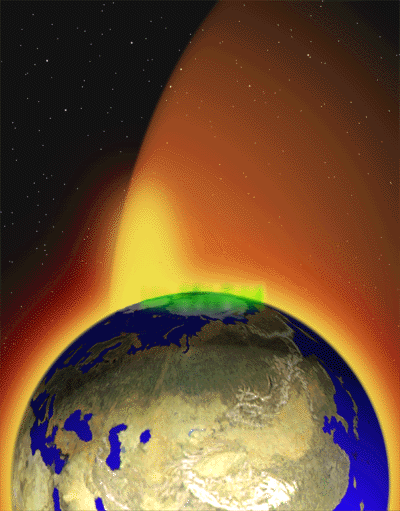
Polar wind
Encyclopedia

Ionization
Ionization is the process of converting an atom or molecule into an ion by adding or removing charged particles such as electrons or other ions. This is often confused with dissociation. A substance may dissociate without necessarily producing ions. As an example, the molecules of table sugar...
gas (plasma
Plasma (physics)
In physics and chemistry, plasma is a state of matter similar to gas in which a certain portion of the particles are ionized. Heating a gas may ionize its molecules or atoms , thus turning it into a plasma, which contains charged particles: positive ions and negative electrons or ions...
) from the polar regions of the magnetosphere
Magnetosphere
A magnetosphere is formed when a stream of charged particles, such as the solar wind, interacts with and is deflected by the intrinsic magnetic field of a planet or similar body. Earth is surrounded by a magnetosphere, as are the other planets with intrinsic magnetic fields: Mercury, Jupiter,...
, caused by the interaction between the solar wind
Solar wind
The solar wind is a stream of charged particles ejected from the upper atmosphere of the Sun. It mostly consists of electrons and protons with energies usually between 1.5 and 10 keV. The stream of particles varies in temperature and speed over time...
and the Earth's atmosphere. The solar wind ionizes gas molecules in the upper atmosphere to such high energy that some of them reach escape velocity and pour into space. A considerable percentage of these ions remain bound inside Earth's magnetic field where they form part of the radiation belts
Van Allen radiation belt
The Van Allen radiation belt is a torus of energetic charged particles around Earth, which is held in place by Earth's magnetic field. It is believed that most of the particles that form the belts come from solar wind, and other particles by cosmic rays. It is named after its discoverer, James...
.
The term was coined in 1968 in a pair of articles by Banks and Holzer and by Ian Axford
Ian Axford
Sir William Ian Axford, FRS, FRSNZ , was a New Zealand space scientist who was director of Germany's Max Planck Institute for Aeronomy from 1974 to 1990...
. Since the process by which the ionospheric plasma flows away from the Earth along magnetic field lines is similar to the flow of solar plasma away from the sun's corona (the solar wind
Solar wind
The solar wind is a stream of charged particles ejected from the upper atmosphere of the Sun. It mostly consists of electrons and protons with energies usually between 1.5 and 10 keV. The stream of particles varies in temperature and speed over time...
), Axford suggested the term "polar wind." The idea for the polar wind originated with the desire to solve the paradox of the terrestrial helium
Helium
Helium is the chemical element with atomic number 2 and an atomic weight of 4.002602, which is represented by the symbol He. It is a colorless, odorless, tasteless, non-toxic, inert, monatomic gas that heads the noble gas group in the periodic table...
budget. This paradox consists of the fact that helium in the Earth's atmosphere seems to be produced (via radioactive decay of uranium
Uranium
Uranium is a silvery-white metallic chemical element in the actinide series of the periodic table, with atomic number 92. It is assigned the chemical symbol U. A uranium atom has 92 protons and 92 electrons, of which 6 are valence electrons...
and thorium
Thorium
Thorium is a natural radioactive chemical element with the symbol Th and atomic number 90. It was discovered in 1828 and named after Thor, the Norse god of thunder....
) faster than it is lost by escaping from the upper atmosphere. The realization that some helium could be ionized, and therefore escape the earth along open magnetic field lines near the magnetic poles (the 'polar wind'), is one possible solution to the paradox.
Further research came from the Retarding Ion Mass Spectrometer instrument on the Dynamics Explorer
Dynamics Explorer
Dynamics Explorer was a NASA mission, launched on August 3, 1981 and terminated on February 28, 1991. It consisted of two unmanned satellites, DE-1 and DE-2, whose purpose was to investigate the interractions between plasmas in the magnetosphere and those in the ionosphere...
spacecraft
Spacecraft
A spacecraft or spaceship is a craft or machine designed for spaceflight. Spacecraft are used for a variety of purposes, including communications, earth observation, meteorology, navigation, planetary exploration and transportation of humans and cargo....
, in the 1980s. Recently, the SCIFER sounding rocket
Sounding rocket
A sounding rocket, sometimes called a research rocket, is an instrument-carrying rocket designed to take measurements and perform scientific experiments during its sub-orbital flight. The origin of the term comes from nautical vocabulary, where to sound is to throw a weighted line from a ship into...
was launched into the plasma
Plasma (physics)
In physics and chemistry, plasma is a state of matter similar to gas in which a certain portion of the particles are ionized. Heating a gas may ionize its molecules or atoms , thus turning it into a plasma, which contains charged particles: positive ions and negative electrons or ions...
heating region of the fountain.

